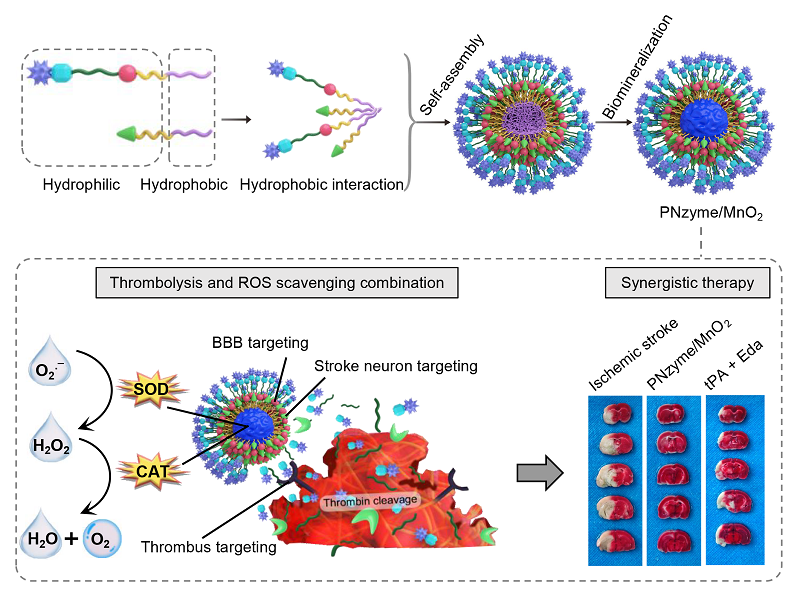Recent advances in peptide-based antioxidant nanozymes for the treatment of ischemic stroke
As one of the International Union of Pure and Applied Chemistry (IUPAC) Top Ten Emerging Technologies in Chemistry 2022, nanozymes demonstrate a unique amalgamation of natural and artificial catalytic properties, resulting in reaction kinetics that closely resemble those exhibited by natural enzymes. Consequently, they hold great potential as a viable substitute for enzymes in various human health applications. Nanozymes are also characterized by high stability, low cost, and relatively simple large-scale production, thus overcoming the limitations of natural enzymes. In addition, the capability to design and the versatility of nanomaterials offer considerable potential for diverse industrial, medical, and biological applications. The utilization of the distinctive characteristics of nanozymes, such as their multi-enzyme activity, multifunctionality, and substrate catalysis, is currently a crucial area of focus in the field of nanozyme research. This pursuit is expected to advance the development of innovative technologies that will effectively address the challenges associated with the use of natural enzymes or other catalysts.
Recently, Yan et al. developed a peptide-based antioxidant nanozyme (Figure 1) with the goal of tackling the issues of high mortality and disability rates, as well as the absence of effective and safe therapeutic medications for ischemic stroke. In this system, the MnO2 nanozyme synergistically combines the catalytic activities of superoxide dismutase (SOD) and catalase (CAT), along with a self-assembled peptide nanoparticle that facilitates targeted thrombolysis. The catalytic cascade reactions mediated by SOD and CAT can eliminate reactive oxygen species (ROS) from the lesion area. The findings of animal studies revealed that this peptide-based antioxidant nanozyme can promote the repair of ischemia-reperfusion injury while effectively facilitating thrombolysis, thereby alleviating oxidative stress in ischemic brain tissue and reducing the non-specific adsorption and toxic side effects of the nanozyme. This research, which was published online in Advanced Materials in March 2023, thus offers a potentially novel approach for the treatment of ischemic stroke.
The design of this novel nanozyme involves the combination of two self-assembling polypeptide chains that form nanoparticles of 15 nm in diameter, with surface polypeptides containing a targeted thrombolytic module, a thrombin response module, a blood-brain barrier-crossing module and a brain ischemic neuronal targeting module. The metal ion affinity peptide in the core is used as a template to synthesize the MnO2 nanozyme via the process of biomineralization. The results indicated that this peptide-based antioxidant nanozyme has SOD (>2100 U/mg) and CAT (~300 U/mg) catalytic activities comparable to those of natural enzymes with the functional properties of targeted thrombolysis and ROS scavenging from outside inward. Initially, the peptide on the outer surface specifically binds to fibrin in the thrombus and releases the thrombolytic peptide in response to thrombin, thereby initiating thrombolytic activity, which in turn targets the blood-brain barrier transferrin receptor, facilitating entry into the brain tissue affected by ischemia-hypoxia. Herein, the nanozyme activates a dual SOD-CAT enzymatic cascade, in which SOD converts O2·- to H2O2 and H2O, and CAT converts the highly cytotoxic H2O2 to nontoxic H2O and O2, thereby safely and effectively eliminating ROS. Evaluation of this system in mouse and rat models of ischemic stroke revealed substantial neurological recovery, with over 90% reduction in infarct volume. Moreover, the therapeutic efficacies are superior to those obtained with the thrombolytic agent tissue-type plasminogen activator (tPA) and neuroprotective agent edaravone (Eda), which are currently used in clinical practice. This enhanced efficacy can be attributed to the fact that the multifunctionality of the peptide enables the nanozyme to precisely target stoke-associated ischemic tissue and ensure biological safety. Importantly, the nanoscale therapeutic system facilitates prolongation of the cascading enzymatic activity, thereby overcoming the limitations of short half-life, low bioavailability, and severe toxic side effects of the currently available small-molecule drugs. This nanoscale therapeutic system also lays a foundation for the development of further novel systems that will contribute to the comprehensive, safe, and effective treatment of ischemic stroke.

Figure 1. Schematic diagrams illustrating the synthesis of the thrombin-responsive peptide-based antioxidant nanozyme and its application in the treatment of ischemic stroke.
Prof. YAN Xiyun and Prof. FAN Kelong from the Institute of Biophysics, Chinese Academy of Sciences, are co-corresponding authors of the present study. WANG Zhuoran (Assistant Professor) and ZHAO Yue (Doctoral student) from the Institute of Biophysics, Chinese Academy of Sciences, are co-first authors. This research was supported by the National Natural Science Foundation of China, the National Key Research and Development Program of China, CAS Interdisciplinary Innovation Team, Youth Innovation Promotion Association of Chinese Academy of Sciences, China Postdoctoral Science Foundation, and the Beijing Nova Program.
Link to the article: https://onlinelibrary.wiley.com/doi/full/10.1002/adma.20221014
Contact: FAN Kelong
Institute of Biophysics, Chinese Academy of Sciences
Beijing 100101, China
Email: fankelong@ibp.ac.cn
(Reported by Dr. FAN Kelong's group)

